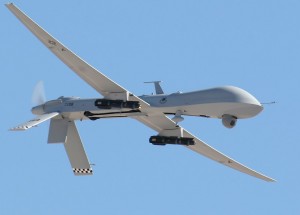US drones to patrol Pakistan’s tribal areas even after Afghan withdrawal
Wednesday, July 24th, 2013 1:58:49 by Tahir Khan
U.S. officials have stressed that the CIA is expected to maintain a significant footprint even after the pullback from Afghanistan, with a station in Kabul that will remain among the agency’s largest in the world, as well as a fleet of armed drones that will continue to patrol Pakistan’s tribal belt, The Washington Post reported Wednesday.
The CIA’s armed drones are flown from a heavily fortified airstrip near the Pakistan border in Jalalabad.
The CIA has begun closing clandestine bases in Afghanistan, marking the start of a drawdown from a region that transformed the agency from an intelligence service struggling to emerge from the Cold War to a counterterrorism force with its own prisons, paramilitary teams and armed Predator drones.
The pullback represents a turning point for the CIA as it shifts resources to other trouble spots. The closures were described by U.S officials as preliminary steps in a plan to reduce the number of CIA installations in Afghanistan from a dozen to as few as six over the next two years — a consolidation to coincide with the withdrawal of most U.S. military forces from the country by the end of 2014.
Afghanistan wants U.S. military to pay $70 million for cargo being shipped out of the country.
Senior U.S. intelligence and administration officials said the reductions are overdue in a region where U.S. espionage efforts are now seen as out of proportion to the threat posed by al-Qaeda’s diminished core leadership in Pakistan.
The CIA faces an array of new challenges beyond al-Qaeda, such as monitoring developments in the Middle East and delivering weapons to rebels in Syria. John O. Brennan, the recently installed CIA director, has also signaled a desire to restore the agency’s focus on traditional espionage.
“When we look at post-2014, how does the threat in Afghanistan and Pakistan measure against the threat in North Africa and Yemen?” said a senior administration official who spoke on the condition of anonymity to discuss government deliberations. “Shouldn’t our resources reflect that?”
The timing and scope of the CIA’s pullback are still being determined and depend to some extent on how many U.S. troops President Obama decides to keep in the country after 2014. The administration is expected to reduce the number from 63,000 now to about 10,000 after next year but recently signaled that it is also considering a “zero option,” in part because of mounting frustration with Afghan President Hamid Karzai.
The CIA may be in a unique position to negotiate with Karzai, who has publicly acknowledged accepting bags of money from the agency for years. The CIA also has provided much of the budget and training for the Afghan intelligence service. The agency wants to maintain the strength of those ties.
Even so, a full withdrawal of U.S. troops would probably trigger a deeper retrenchment by the CIA, which has relied on U.S. and allied military installations across the country to serve as bases for agency operatives and cover for their spying operations.
The CIA’s presence in the country has already dropped well below the peak levels of several years ago, when more than 1,000 case officers, analysts and other employees had been deployed to support the war effort and hunt al-Qaeda leaders, including Osama bin Laden.
Tags: Al-Qaeda, CIA, Jalalabad, Osama bin Laden, Pakistan tribal belt, The Washington Post, US drones, US-Afghan withdrawalShort URL: https://www.newspakistan.pk/?p=41007

















